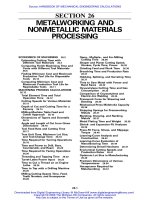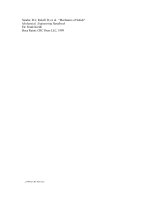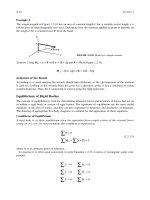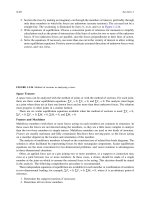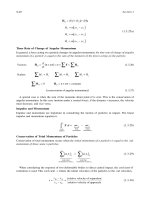CRC Press - Mechanical Engineering Handbook- Mechanics Of Solids Part 13 pot
Bạn đang xem bản rút gọn của tài liệu. Xem và tải ngay bản đầy đủ của tài liệu tại đây (31.89 KB, 1 trang )
1-120 Section 1
Multiaxial Fatigue
Complex states of stress are common in engineering components, and in fatigue analysis they may cause
serious difficulties. There are many methods available, but none of them are adequate for all cases. The
simplest situations that might be handled reasonably well involve fully reversed loading by in-phase or
180° out-of-phase proportional stresses at the same frequency. Multiaxial fatigue testing is difficult and
expensive, so it is often desired to use uniaxial test data for predicting the multiaxial behavior. A typical
approach for this is based on computing an effective stress amplitude σ
e
from the amplitudes of the
principal stresses σ
1a
, σ
2a
, σ
3a
. With the concept of the octahedral shear yield criterion,
(1.6.18)
where in-phase stresses are positive and 180° out-of-phase stresses are negative.
The life is estimated by entering σ
e
on the appropriate S-N curve. Note that mean stresses, localized
or general yielding, creep, and random frequencies of loading further complicate the problem and require
more sophisticated methods than outlined here.
Strain vs. Life (ε-N) Curves
A strain-based approach is necessary in fatigue when measurable inelastic strains occur. In general, total
strain consists of elastic, plastic, and creep strains, with the latter two being in the category of inelastic
strains,
(1.6.19)
When ε
p
or/and ε
c
are dominant, the life is relatively short and the situation is called low-cycle fatigue
(LCF), as opposed to high-cycle fatigue (HCF), where ε
e
is dominant. The mechanics of LCF can be
understood by first considering hysteresis loops of elastic and plastic strains as defined in Figure 1.6.25.
Simplistically, HCF means a thin loop (a straight line at very long life) and LCF means a fat loop.
Strain-life plots are especially useful in the LCF regime where material properties (ε
f
, σ
f
) obtained in
monotonic tension tests are directly useful in fatigue life prediction as shown in Figure 1.6.26. Most
commonly the total strain amplitude ε
a
is plotted vs. the life 2N
f
, with a corresponding equation (called
Coffin-Manson equation) for fully reversed loading,
(1.6.20)
FIGURE 1.6.25Hysteresis loop.
σσσσσσσ
eaaaaaa
=−
()
+−
()
+−
()
1
2
12
2
23
2
31
2
εεεε
tepc
=++
ε
σ
ε
a
f
f
b
ff
c
E
NN=
()
+
()
22




